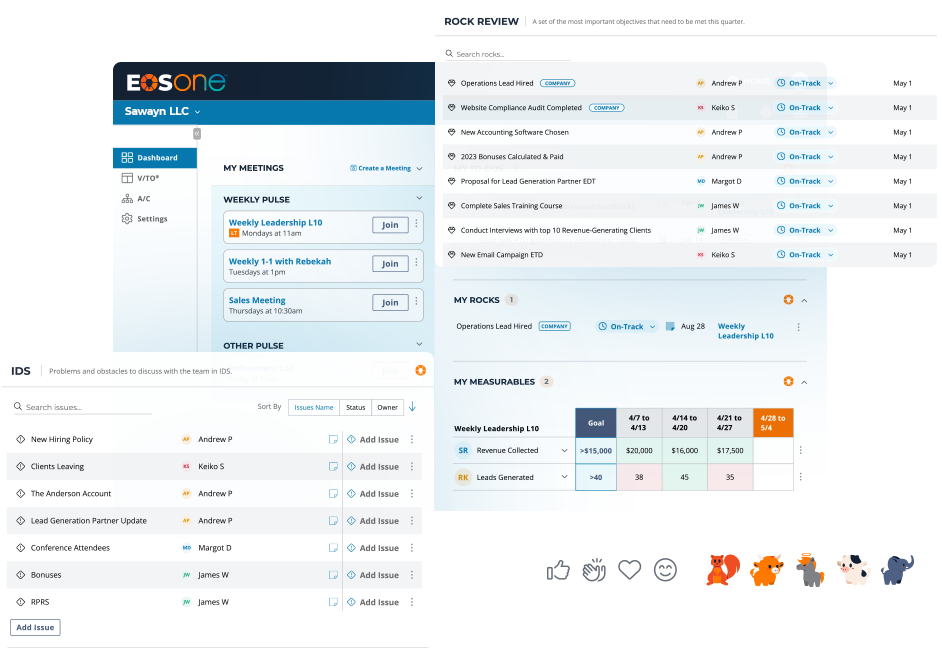Do you ever find yourself waking up in the middle of the night, wondering where things are at in your business? Have you been woken up going, “Oh, my God, I’ve got to go talk to them, and then them, and then them?” The people’s faces are in your head, and your body’s tired and you’d love to go back to sleep…
But you know it’s not gonna happen. I get it. I’ve been there too. It’s frustrating to not have a pulse on your business, and it creates stress when you need to have five different conversations first thing in the morning to get the data you’re looking for. The EOS Scorecard™ is the solution to better data and a better night’s sleep…
So what is an EOS Scorecard? It’s this simple but dynamic tool that drives accountability and performance within organizations. It consists of a handful of weekly, activity-based numbers that we at EOS® call Measurables. Your Scorecard reflects the health of the company, and it enables informed decision-making to track progress on a weekly basis.
Think of it as a compass guiding you toward your destination. When you’re running your business using the EOS Scorecard, it can be beneficial for a number of reasons. First, your Scorecard provides the data to see patterns, to identify areas of improvement, and to celebrate milestones. It’s also a powerful driver of accountability…
As Gino Wickman, founder of EOS Worldwide, said, “Hitting a number is the essence of accountability.” Additionally, your Scorecard allows you to make proactive decisions. It lets you dial things in – not monthly or quarterly, but every single week! You know exactly where you are and you can see both positive and negative trends before they become problems because you’re looking at it every single week.
Having clear, regular data also allows employees to know where they stand. When every person has a number, they can compete with themselves to improve, and they can gauge their progress as part of the team.
Numbers don’t lie. Your Scorecard takes the emotion and the subjectivity out of difficult conversations or things that just plain aren’t working. Think of it this way…
Just like a pilot constantly makes small course corrections to stay on track from point A to point B, your Scorecard helps you make those adjustments in your business.
As I like to say to clients, “Would you like to have 52 opportunities for that plane to correct? Would you like to have 12? Would you like to have six? Would you like to have four?” Me? I would like 52-plus! So when you get your Scorecard right, it gives you action-oriented behavioral opportunities to adjust.
You can create your own Scorecard using the following steps:
Start by identifying 5 to 15 weekly activity-based Measurables that give you an absolute pulse on your business. These could be sales targets, customer satisfaction ratings, or production efficiency metrics, to name a few.
Ensure those Measurables align with your long-term vision and the goals that you’re setting. If you need help identifying the right Measurables, picture yourself on a beautiful tropical island with no phone, no internet, no access to anyone or anything relative to your business. Your only connection to how things are going is a weekly printout of your Scorecard.
If a cabana boy or a cabana girl could bring you one piece of paper and you had no means to call back, email back, write back, communicate back to the mothership, what would you need to know? Those become your Measurables. Finally, you have to assign each Measurable to someone based on their role in The Accountability Chart™.
They own that Measurable and might have two or three more?, and they’re responsible for keeping it on track. Looking to The Accountability Chart can be a great source of figuring out key Measurables that help you and your business maintain a pulse on the health of that team, that person, or that part of your company.
Secondly, another place to find great Measurables is in your documented processes. If you’re not measuring things, you can’t have compliance. Otherwise, you’ve got to lord it over people. So what is the frequency, the compliance, or the outcome you are seeking by having your processes in place? Look at the touchpoints in those processes.
And say, what would need to happen? How often would it need to happen? What would indicate a quality outcome for us? And measure that. Measurements can be in time, they can be in currency, they can be in percentages, they can be in straight-up numbers, or they can be yeses or nos. All of those things give us data to measure how well we’re doing.
Once you’ve created your Scorecard, you have to review it weekly during your EOS® Level 10 Meeting™. Any numbers off track immediately drop down to the Issues List for discussions. One week off, OK, you get the opportunity to correct that. Two weeks off is a trend coming. Let’s not let the pattern get started.
Let’s get in. Let’s talk about it. Let’s figure out what needs to change, and it should point to a behavior that needs to change. You want to treat your Scorecard like a dashboard, providing real-time insights into your organization’s performance. You want to celebrate wins, address challenges using the Issues List, and adjust your strategies based on that Scorecard data.
I have an engineering company as a client. They came into one of our quarterly sessions, and they were reporting on their Scorecard. Now in EOS, it’s really clear. It’s either on or off track.
It’s no more complex than that, but these are engineers, so they like to get creative. And what they ended up doing was assigning a color chart. Now, for some of you, if you’ve done the color chart – red, yellow, and green–please don’t take this personally, but stop it! Yellow is a red coming.
That’s an issue, not a problem. Red is a problem. So when they came in, they said, “Sue, we did this color coding with yellow, red, and green.” And I said, “Well, what’s yellow?” And they said, “Yellow is a good red.” Now, I laughed out loud quite profusely, so if you aren’t smiling at least, you’re off track too.
Yellow is not a good red. There’s no such thing as a good red! It is on or off track. Please don’t complicate this tool because it means performing those activities that lead to the outcomes we want and it should drive everything in your goals with your processes and really point to the accountability for each seat in your Accountability Chart.
If it takes you a bit to identify the right Measurables for your Scorecard, don’t worry. Most companies go through iterations of their Scorecard over time. It’s all about trial and error. It might take a while to find the right mix.
You’ve got to be patient. It is worth it. You cannot think your way to a perfect Scorecard. You have to get a rough draft and just do it. You will figure it out quickly and iterate. Please trust me. Do not spend hours trying to get the right numbers. It’s also useful to evaluate your Scorecard quarterly.
Sometimes in seasonal businesses, you have to be adjusting or you’ll be in the red all the time. You never want to go numb to your numbers. Identify any Measurables that could be missing on a quarterly basis and identify those that might no longer be relevant. Make the adjustments and edit until you love it.
As your business priorities change, your Scorecard will change as well. The weekly data provided by an EOS Scorecard allows you to see the health of your business on a single document. It allows you to identify trends, solve issues before they become problems, and keep accountability strong throughout your organization.











